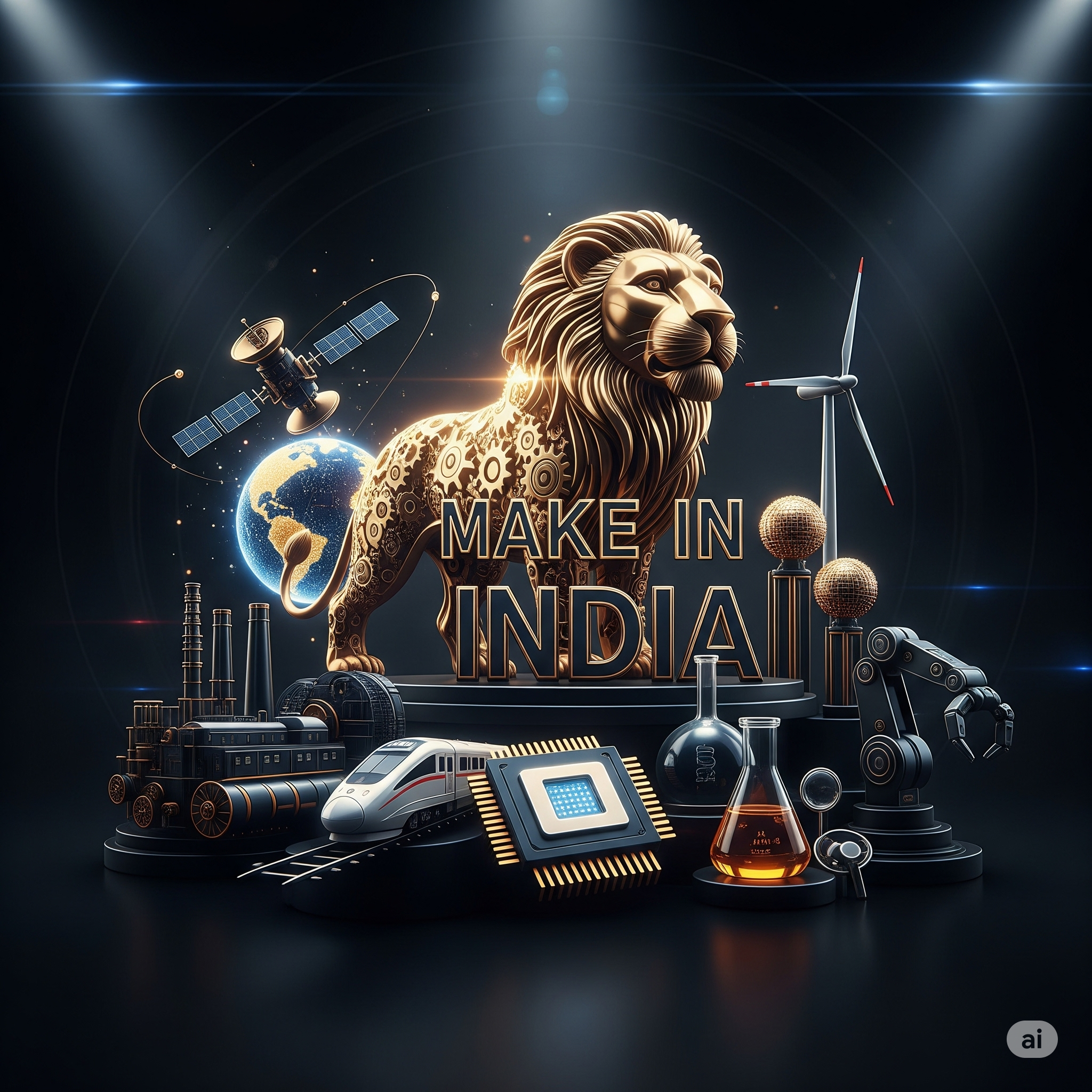Introduction
India, one of the fastest-growing economies in the world, has long aspired to become a global manufacturing hub. With its large workforce, growing domestic market, and favorable geographical location, the country has immense potential to strengthen its industrial base. To realize this potential, the Government of India launched the “Make in India” initiative on September 25, 2014, under the leadership of Prime Minister Narendra Modi.
The program aims to transform India into a global design and manufacturing hub, attract foreign investment, encourage domestic industries, create jobs, and promote innovation. It is not just a policy but a vision to position India as a key player in the global value chain. Over the years, Make in India has achieved significant progress, but it also faces structural challenges that must be addressed for long-term sustainability.
This article explores the background, objectives, achievements, and challenges of the Make in India initiative, along with its future prospects.
Background and Objectives of Make in India
Context Before 2014
- India had been primarily a services-driven economy, with limited manufacturing contribution to GDP.
- Manufacturing sector contributed around 15-16% of GDP, much lower compared to countries like China (30%) and South Korea (25%).
- The country faced high unemployment, trade deficit, and dependence on imports in critical sectors such as electronics, defense equipment, and machinery.
Objectives of Make in India
- Boost Manufacturing Growth – Increase the share of manufacturing in GDP to 25%.
- Job Creation – Generate 100 million additional manufacturing jobs by 2022.
- Ease of Doing Business – Improve India’s ranking by reducing red tape and simplifying regulations.
- FDI Promotion – Attract foreign direct investment in key sectors.
- Infrastructure Development – Build world-class industrial corridors, smart cities, and logistics networks.
- Skill Development – Provide training to enhance employability.
- Self-Reliance – Reduce import dependence and promote indigenous production.
Key Features of Make in India
- Covers 25 sectors such as automobiles, textiles, defense, railways, construction, IT, chemicals, and renewable energy.
- FDI Reforms – Liberalized foreign investment rules in defense, aviation, and insurance sectors.
- Single-Window Clearance for investors to reduce bureaucratic delays.
- Development of industrial corridors like Delhi-Mumbai Industrial Corridor (DMIC).
- Integration with other flagship schemes such as Digital India, Startup India, and Skill India.
- Focus on innovation, entrepreneurship, and global competitiveness.
Achievements of Make in India
1. Foreign Direct Investment (FDI) Growth
- India attracted record FDI inflows post-2014.
- Between 2014 and 2023, cumulative FDI inflows crossed USD 600 billion, making India one of the top investment destinations.
- Key sectors attracting FDI: computer software and hardware, telecom, construction, and automobiles.
2. Improvement in Ease of Doing Business
- India jumped from 142nd position in 2014 to 63rd in 2020 in the World Bank’s Ease of Doing Business rankings.
- Reforms included simplification of procedures, digitization of approvals, and reduction in compliance burden.
3. Infrastructure Development
- Expansion of industrial corridors and logistics hubs.
- Increased investment in highways, ports, airports, and dedicated freight corridors.
- Power sector reforms improved electricity availability for industries.
4. Growth of Manufacturing Sectors
- Automobile industry became the fourth-largest in the world.
- Mobile phone manufacturing boomed, with India becoming the second-largest producer globally.
- Defense production increased with more indigenous equipment and private sector participation.
5. Job Creation and Entrepreneurship
- Programs like Startup India and Skill India complemented Make in India by encouraging youth entrepreneurship.
- Growth of MSMEs (Micro, Small, and Medium Enterprises) contributed to local job creation.
6. Digital and Technological Advancement
- Digital India enabled industries to adopt e-governance and digital payments.
- Startups innovated in fields like AI, fintech, and e-commerce, strengthening industrial growth.
7. Renewable Energy Push
- India became one of the top renewable energy producers, with significant solar and wind capacity installed.
- Helped attract global companies to invest in clean energy manufacturing.
Sectoral Success Stories
1. Automobile Industry
- Global players like Hyundai, Suzuki, Kia, and Tesla showed interest in India.
- Rise in electric vehicle (EV) startups such as Ola Electric and Ather Energy.
2. Electronics and Mobile Manufacturing
- Companies like Apple, Samsung, and Xiaomi started assembling/manufacturing in India.
- Production Linked Incentive (PLI) schemes further boosted electronics manufacturing.
3. Defense and Aerospace
- Increased domestic defense production under “Atmanirbhar Bharat”.
- Partnerships with global giants like Boeing, Lockheed Martin, and Dassault.
4. Textiles and Garments
- Boosted India’s traditional strength in textiles with modern infrastructure.
- Export competitiveness improved in global markets.
Challenges Facing Make in India
1. Infrastructure Gaps
- Despite improvements, India still lags in logistics, supply chains, and transportation.
- High cost of electricity, land acquisition, and logistics increase manufacturing costs.
2. Skill Shortages
- Mismatch between industry needs and workforce skills.
- Vocational training programs are insufficient to meet industry demands.
3. Regulatory and Bureaucratic Hurdles
- Despite reforms, businesses often face delays in land approvals, environmental clearances, and tax disputes.
4. Dependence on Imports
- Heavy reliance on imports for electronics, semiconductors, and defense equipment persists.
- Trade deficit remains a challenge.
5. Global Competition
- Competing with China, Vietnam, and Bangladesh in low-cost manufacturing.
- Need for India to enhance productivity and innovation.
6. Technology and R&D Gap
- Limited investment in research and innovation compared to global standards.
- Need for stronger collaboration between academia, industry, and government.
7. Environmental Concerns
- Rapid industrialization may lead to pollution and ecological damage.
- Balancing growth with sustainability is critical.
Impact of COVID-19 on Make in India
- Initially disrupted supply chains and slowed investments.
- However, it also highlighted the need for self-reliance (Atmanirbhar Bharat).
- Led to diversification of supply chains as global companies sought alternatives to China.
- Accelerated digital adoption and e-commerce growth.
Government Initiatives Supporting Make in India
- Production Linked Incentive (PLI) Schemes – Incentives for companies in electronics, pharma, automobiles, and other sectors.
- National Infrastructure Pipeline (NIP) – Investment plan of USD 1.4 trillion to boost infrastructure.
- Atmanirbhar Bharat Abhiyan – Self-reliance mission promoting domestic manufacturing.
- Startup India – Support for innovation-driven entrepreneurship.
- Skill India Mission – Training youth in industry-relevant skills.
Future Prospects
- India aims to become a $5 trillion economy by 2027, with manufacturing playing a crucial role.
- Sectors with high potential: semiconductors, renewable energy, EVs, defense, textiles, and healthcare.
- Global investors increasingly view India as a China-plus-one strategy destination.
- With sustained reforms, India can position itself as a global manufacturing hub by leveraging its demographic dividend and large domestic market.
Conclusion
The Make in India initiative has significantly transformed India’s industrial landscape by attracting investments, improving ease of doing business, and creating opportunities across diverse sectors. It has helped position India as a rising global manufacturing hub, especially in electronics, automobiles, and defense.
However, challenges such as infrastructure bottlenecks, skill shortages, import dependence, and regulatory complexities continue to hinder progress. To fully realize the vision of Make in India, sustained reforms, technological advancements, and stronger global competitiveness are essential.
In essence, Make in India is not just about manufacturing—it is about building a self-reliant, innovative, and globally competitive India. With consistent efforts, India has the potential to emerge as a leader in sustainable and inclusive industrial growth.




